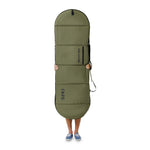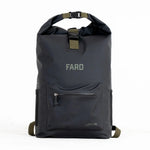
For generations, surfers have shared an unparalleled connection with the ocean – a connection built on respect, awe, and an intimate understanding of its power and beauty. Yet, the very act of surfing, and particularly the gear we use, can inadvertently contribute to the environmental challenges facing our beloved marine ecosystems. As awareness grows about plastic pollution, chemical runoff, and carbon footprints, the call for eco-friendly surfing practices has become louder and more urgent.
This guide is dedicated to the environmentally conscious surfer. We will explore how making deliberate choices when selecting sustainable surfing gear can significantly reduce your ecological impact. From innovative materials in surfboards and wetsuits to the often-overlooked importance of eco-friendly surfboard bags and other sustainable surf accessories, every decision contributes to a healthier ocean and a greener surfing future.
The Call for Sustainable Surfing Practices
The ocean is our playground, our sanctuary, and our source of immense joy. However, the production and disposal of traditional surf equipment often involve processes and materials that are far from environmentally benign. Recognizing this impact is the first step towards embracing a more responsible surfing lifestyle.
Why Sustainability Matters in Surfing
Traditional surfboards, wetsuits, leashes, and accessories often rely heavily on petrochemicals, non-biodegradable plastics, and energy-intensive manufacturing processes.
- Plastic Pollution: Many conventional surf accessories contribute to the vast amounts of plastic waste that end up in our oceans, harming marine life and breaking down into persistent microplastics.
- Chemical Leaching: From petroleum-based wetsuits to conventional surf wax, various chemicals can leach into the water, impacting marine ecosystems.
- Carbon Footprint: The entire lifecycle of traditional surf gear, from raw material extraction to manufacturing and shipping, contributes to greenhouse gas emissions.
- Landfill Burden: Non-recyclable and non-biodegradable surf equipment ultimately adds to overflowing landfills, persisting for centuries.
The Rise of the Eco-Conscious Surfer
The surfing community, by its very nature, is deeply intertwined with the health of the ocean. This intimate relationship fuels a growing movement of surfers who are not just riders of waves but also passionate protectors of the marine environment. The eco-conscious surfer actively seeks ways to minimize their footprint, understanding that preserving the ocean is essential for the future of the sport itself. This includes demanding transparency from brands and actively seeking out green surfing practices.
Essential Sustainable Surfing Gear & Accessories
The good news is that innovation in sustainable materials and manufacturing is rapidly expanding within the surf industry. There are now numerous viable, high-performance alternatives to traditional gear.
Eco-Friendly Surfboard Bags: Protecting Your Board and the Planet
Often seen as just a protective cover, your surfboard bag also has an environmental story. Traditional bags often use virgin polyester, a petroleum-derived plastic.
- Recycled Polyester (rPET): Many leading brands, including Faro Board Bags, are now utilizing recycled polyester made from discarded plastic bottles. This diverts waste from landfills and oceans and significantly reduces energy consumption and CO2 emissions compared to virgin polyester production.
- Natural Fibers: Some emerging options include bags made from hemp, organic cotton, or even bamboo, offering natural, biodegradable alternatives.
- Durable & Repairable Design: A truly sustainable bag is one that lasts. Look for reinforced stitching, robust zippers, and quality craftsmanship that extends the product's lifespan, reducing the need for frequent replacements. Faro Board Bags exemplifies this commitment to durability and sustainability.
Sustainable Surfboards: Riding Waves, Respecting the Earth
The core of your quiver can be made more sustainably.
- Bio-Resins: Replacing traditional petroleum-based epoxy resins with plant-based alternatives (e.g., from soy or algae) significantly reduces the chemical footprint.
- Recycled Foam Cores: Some boards now incorporate recycled EPS foam from packaging or other sources, diverting waste from landfills.
- Natural Fibers: Using flax, basalt, or even wood veneers instead of fiberglass can reduce reliance on synthetic materials and offer unique flex characteristics.
- Closed-Loop Manufacturing: Supporting shapers and brands that prioritize waste reduction and material recovery in their production processes.
Environmentally Sound Wetsuits: Warmth Without the Guilt
Traditional neoprene wetsuits are petroleum-based and highly detrimental to the environment. Greener alternatives are now widely available.
- Limestone Neoprene: While still synthetic, limestone-based neoprene requires less petroleum and is generally considered more eco-friendly than petroleum-derived neoprene.
- Natural Rubber (Yulex): This is perhaps the most significant innovation. Yulex natural rubber is plant-based, derived from sustainably harvested trees, and offers comparable performance to traditional neoprene with a far lower environmental impact.
- Recycled Materials: Wetsuits incorporating recycled plastics for their liners or outer fabrics are also becoming more common.
Green Surf Accessories: Small Changes, Big Impact
It’s often the small things that add up. Opting for sustainable choices in everyday accessories makes a significant difference.
- Sustainable Leashes: Look for leashes made from recycled plastic (rPET), plant-based TPU, or natural rubber, offering durability without the heavy environmental cost.
- Eco-Friendly Surf Wax: Traditional surf wax often contains petrochemicals. Choose waxes made from natural, biodegradable ingredients like beeswax, soy, coconut oil, or other plant-based compounds, ensuring no harmful chemicals are left in the water.
- Reef-Safe Sunscreen: Many conventional sunscreens contain oxybenzone and octinoxate, chemicals known to harm coral reefs. Opt for mineral-based sunscreens with non-nano zinc oxide and titanium dioxide as active ingredients.
- Fin Alternatives: Some fins are now made from recycled plastics or plant-based composites, providing performance while minimizing waste.
- Surf Apparel: Choose boardshorts, rashguards, and casual wear made from organic cotton, recycled polyester, hemp, or other low-impact fibers.
Beyond the Gear: Green Surfing Practices
While choosing the right gear is crucial, sustainable surfing extends to our habits and mindset both in and out of the water.
Mindful Consumption
- Repair Over Replace: Extend the life of your gear by repairing dings, tears, and worn parts rather than immediately buying new.
- Buy Less, Buy Better: Invest in high-quality, durable sustainable products that will last, reducing overall consumption.
- Secondhand & Upcycled: Consider buying used gear or supporting brands that upcycle old surf equipment into new products.
Supporting Sustainable Brands
Do your research. Support companies that prioritize transparency, use ethical labor practices, minimize waste in their production, and actively contribute to ocean conservation efforts. Look for certifications and clear communication about their sustainability initiatives.
Waste Reduction at the Beach
- Leave No Trace: Always pack out everything you pack in. Go beyond and pick up any litter you find.
- Reusable Bottles & Bags: Avoid single-use plastics by bringing your own water bottle and reusable bags to the beach.
- Proper Waste Disposal: Dispose of any trash in designated bins, and if possible, sort recyclables.
To illustrate the increasing availability and impact of choosing sustainable surf gear, here's a comparison of common materials and their eco-friendly alternatives:
|
Component Category |
Traditional Material/Practice |
Sustainable Alternative |
Environmental Benefit |
|
Surfboard Bag |
Virgin Polyester |
Recycled Polyester (rPET), Hemp, Organic Cotton |
Reduces plastic waste, lower energy/water use, renewable |
|
Surfboard Foam |
Petroleum-based PU/EPS |
Recycled EPS, Bio-based Foams (e.g., algae) |
Reduces petroleum use, diverts waste, potentially biodegradable |
|
Wetsuit |
Petroleum-based Neoprene |
Limestone Neoprene, Yulex Natural Rubber |
Less petroleum reliance, lower energy consumption, renewable |
|
Surf Wax |
Petrochemical-based |
Beeswax, Soy, Plant-based (natural ingredients) |
Biodegradable, no harmful chemicals in ocean |
|
Leash |
Virgin Urethane/Plastic |
Recycled Plastic, Plant-based TPU |
Reduces plastic waste, lower carbon footprint |
|
Sunscreen |
Oxybenzone/Octinoxate (chemicals) |
Non-nano Zinc Oxide/Titanium Dioxide (mineral) |
Reef-safe, no coral bleaching |
Source: Industry research on sustainable surf manufacturing & material innovation, 2023-2024.
This table highlights that while traditional options have been prevalent, viable and superior sustainable alternatives are readily available across almost all surf gear categories.
Conclusion
Choosing eco-friendly surfing gear is a powerful step towards a more responsible and harmonious relationship with our oceans. Every piece of sustainable surfing gear, from the board you ride to the eco-friendly surfboard bags that protect it, reflects a commitment to minimizing your environmental footprint. As surfers, we have a unique responsibility to protect the very environment that brings us so much joy and fulfillment.
Embrace these green surfing practices by supporting brands that are actively innovating for a healthier planet. Faro Board Bags stands at the forefront of this movement, offering premium sustainable surf accessories and eco-friendly surfboard bags crafted from recycled and durable materials.
Ready to gear up sustainably and protect the waves you love? Explore Faro Board Bags' collection of eco-friendly surf accessories today and make a positive impact with every session.





